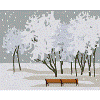Landscape Architecture Program
Date of this Version
August 1992
Abstract
This study investigated woody plant composition, structure, and biomass of hedgerows and fencerows, and for effects between human attitudes and managemnet practices. Fencerows arise as narrow strips of woody and herbaceous plants at feild margins and property boundaries. Hedgerows grow from intentional linear plantings. Exotic species wer more important in fencerow composition. Hackberry, Missouri goosberry, American plum, and white mulberry readily inhabited both fencerows and hedgerows. Woody plant exhibited clumped distribution in both hedgerows and fencerows. A moisture gradient emerged as a factor in distribution of species. Management caused a significant difference in speicies richness and biomass in both hedgerows and fencerows. Hedgerows (discounting the basal area of Osage-orange) had less tree biomass than fencerows and were more evenly distributed between center and margin. For all hedgerows, there was a significant difference between managemen schemes based on preservation-removal attidtude scores.


Comments
Permission to reprint this document has be given by Great Plains Research. Please note that the copyright for this article resides with the Center for Great Plains Studies.